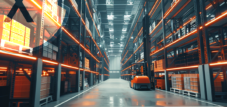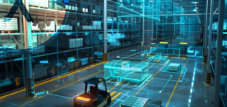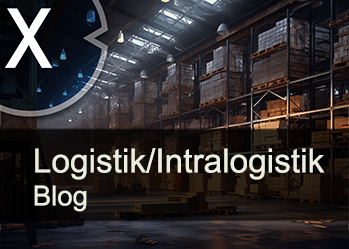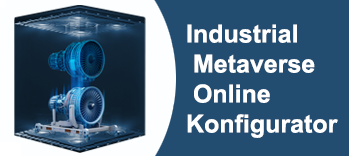In the UK: Food security and automation in food supply through intralogistics
Xpert pre-release
Language selection 📢
Published on: August 20, 2025 / Updated on: August 20, 2025 – Author: Konrad Wolfenstein

In Great Britain: Food security and automation in food supply through intralogistics – Image: Xpert.Digital
The current state of UK food security
How has food security in the UK evolved since the Second World War?
The development of British food security has undergone dramatic change over the past decades. After the end of World War II, the British government recognized food security as a matter of national importance. This led to the passage of the Agriculture Act in 1947, which established a system of guaranteed payments for farmers. These measures were intended to promote the production of vital foodstuffs and ensure the supply of the growing population.
However, the situation has changed fundamentally. By the end of 2024, current statistics show that the UK will only be 62 percent self-sufficient in food production. This figure highlights the country's dependence on imports. To put this in perspective: If the UK had to live exclusively on food produced domestically, its supply would be exhausted by mid-August each year.
What factors have contributed to this deterioration in self-sufficiency?
Several developments have contributed to the current situation. Brexit and the associated end of the EU's Common Agricultural Policy have changed the framework for British agriculture. The war in Ukraine has further disrupted global supply chains and created uncertainty. General global instability is also contributing to the deterioration of the supply situation.
The November 2024 budget has further exacerbated the situation by placing additional financial pressure on farmers. The new tax regulations are perceived by many farmers as a threat to the already fragile rural economy, which has led to protests. These developments indicate that the self-sufficiency rate could deteriorate further in the coming years.
Strategic considerations for food supply
What strategic approaches should the UK food industry pursue to ensure security of supply?
Given the current challenges, the UK food industry must take a pragmatic approach. Keeping supermarket shelves consistently stocked requires a well-thought-out import-based strategy, combined with the ability to maintain sufficient buffer stocks to offset fluctuations in supply and demand.
Targeted investments in cold chain logistics represent a strategically sound step. While domestically produced goods will continue to play an important role, the UK must leverage the benefits of a resilient system based on overseas products. This requires a modern and efficient infrastructure capable of handling and storing large volumes of imported goods.
Why has building resilience in the supply chain become so important?
The need to build resilience into the supply chain has become a critical concern for the entire industry. Retailers are increasingly forced to protect themselves against various risks. These include infrastructure risks such as failures of transport routes or storage facilities, as well as environmental risks such as extreme weather events or natural disasters.
Experiences of recent years have shown how quickly global events can disrupt supply chains. The COVID-19 pandemic, geopolitical tensions, and climate change have exposed the vulnerability of traditional supply systems. Therefore, companies are increasingly investing in technologies and systems that can respond more flexibly to disruptions.
The role of automation in cold chain logistics
What special challenges does cold storage pose compared to conventional warehousing?
The cold chain industry faces unique challenges that go beyond normal warehousing. It encompasses a wide range of products, including perishable goods such as dairy, frozen foods, and fresh produce. These products require precise temperature control throughout the entire storage and transportation process.
Strict inventory management is another critical aspect. Products must be managed based on expiration dates, best-before dates, and delivery information. This requires a continuous flow of pallet storage, retrieval, and picking based on specific requirements. Fast order fulfillment is also essential to ensure product quality and safety standards.
Cold storage facilities that supply supermarkets and restaurant chains must handle a high product mix, small batches, and rapidly moving inventory. This complexity makes manual processes inefficient and error-prone.
How has the situation for manual labor in British cold storage facilities evolved?
The reliance on manual labor in cold storage facilities has proven increasingly problematic. In the United Kingdom, labor costs have continuously risen, increasing the operating costs of storage facilities. At the same time, occupational health and safety requirements have become more stringent, placing additional burdens on food manufacturers, importers, and retailers.
Traditionally, cold storage facilities relied heavily on manual labor for tasks such as picking, packing, and inventory management. However, this approach led to several problems: workflow inefficiencies, increased labor costs due to the necessary premium pay for working in cold environments, and an increased risk of errors due to the demanding working conditions. Working in cold environments is physically demanding and can lead to health problems, making it difficult to recruit and retain staff.
Automated storage and retrieval systems (AS/RS)
What are AS/RS systems and how do they work in cold storage?
Automated storage and retrieval systems, or AS/RS for short, represent a cornerstone of modern warehouse automation. These systems utilize a sophisticated combination of storage racks, automated shuttles, and cranes to store and retrieve goods with the utmost precision and speed. The focus is on handling high volumes with maximum storage efficiency.
The system's functionality is based on a computer-controlled system that determines the optimal storage location for each pallet or container. Automated cranes or shuttles then transport the goods to this location or pick them up again as needed. The entire system is coordinated by warehouse management software that processes real-time data on inventory, expiration dates, and order information.
What specific benefits do AS/RS systems offer for the cold chain industry?
AS/RS systems offer several key benefits for the cold chain industry. Temperature control is paramount. These systems are specifically designed to operate seamlessly in refrigerated environments. They ensure that temperature-sensitive goods are maintained at the required temperatures throughout the storage and retrieval process, eliminating the need for employees to work in the cold environment for extended periods.
Optimized space utilization is another significant advantage. AS/RS systems utilize vertical space more effectively than traditional storage methods. This allows cold chain warehouses to maximize their storage capacity without having to expand their physical footprint. This feature is particularly valuable in urban areas where land prices are high and available space is limited.
The improved inventory management provided by AS/RS systems is also worth highlighting. These systems feature advanced inventory tracking and management capabilities. Warehouse managers can monitor inventory levels in real time and optimize inventory rotation. This is especially important for perishable goods, as it helps minimize waste and ensure compliance with the first-in, first-out principle.
Increased throughput is another key benefit. Through automated retrieval processes, AS/RS systems significantly reduce the time required for order processing. This not only improves the overall warehouse throughput but also leads to greater customer satisfaction through faster and more reliable deliveries.
Sorting Transfer Vehicles (STVs) and their significance
What are STVs and what role do they play in modern cold storage facilities?
Sortation Transfer Vehicles, or STVs for short, are rail-guided transport systems that represent an important complement to AS/RS systems. They play a crucial role in improving the efficiency and flexibility of cold chain warehouse operations. STVs are specifically designed to transport goods between different areas of the warehouse, particularly between storage racks and picking stations, with minimal human intervention.
These vehicles move through the warehouse on fixed tracks and can navigate autonomously. They are equipped with sensors and control systems that allow them to recognize their surroundings and operate safely. The integration of STVs into the warehouse infrastructure enables a continuous and efficient flow of goods.
Xpert partner in warehouse planning and construction
Cold chain automation: efficiency and scalability through STVs and AS/RS
How exactly do STVs transform cold storage?
STVs bring several transformative elements to cold storage. Dynamic warehouse access is a key factor. STVs seamlessly transport goods to and from AS/RS systems. They can navigate autonomously through narrow aisles and confined spaces to deliver pallets to precisely defined drop-off points. The AS/RS can then retrieve them for storage. This flexibility enables faster retrieval times and smoother workflow orchestration.
Collaborative operation is another important aspect. STVs don't work in isolation but can be used in conjunction with human operators and other automated devices such as robotic arms and conveyor systems. This collaboration streamlines the entire order fulfillment process. The collaborative approach optimizes resource utilization and minimizes bottlenecks in the flow of goods.
Of particular note is the improvement in working environments. By delivering goods to operators outside of refrigerated areas, picking tasks can be carried out in well-lit, safe, and comfortable temperatures. This has a direct positive impact on employee well-being and satisfaction. Healthier and happier employees lead to safer and more productive operations.
The scalability and modularity of STVs offer additional benefits. These systems are inherently scalable, allowing cold chain warehouses to gradually expand their automation capabilities as demand grows. This modular approach to automation ensures that investments remain flexible and can be aligned with evolving business needs.
The practical implementation of automation
How is the practical integration of AS/RS and STVs into existing warehouse structures carried out?
Integrating automation systems into existing warehouse structures requires careful planning and step-by-step implementation. First, a comprehensive analysis of current processes and requirements must be conducted. This includes evaluating the product mix, throughput requirements, available space, and specific temperature requirements.
Physical integration often begins with the installation of the necessary infrastructure. For AS/RS systems, this means erecting high-bay warehouses and installing cranes or shuttles. For STVs, rail systems must be installed to connect the various areas of the warehouse. This work can often be carried out in phases to minimize disruption to ongoing operations.
Software integration is equally important. The automation systems must be connected to the existing warehouse management system (WMS) and other IT systems. This enables seamless data flow and coordinated control of all warehouse activities. Implementation also requires extensive testing and adjustments to ensure that all systems work together optimally.
What challenges need to be overcome during implementation?
Implementing automation systems in cold storage facilities presents specific challenges. The extreme temperature conditions place special demands on the technology used. All components must be designed for low-temperature operation, which requires special materials, lubricants, and electronics.
The investment costs are often significant and require a careful cost-benefit analysis. Companies must weigh the long-term savings from reduced labor costs, increased efficiency, and lower error rates against the initial investment. Financing such projects often requires strategic planning over several years.
Employee training is another critical factor. The introduction of new technologies fundamentally changes the way we work. Employees must be trained in the operation and maintenance of the new systems. This requires time and resources, but is essential for successful operations.
Integration with existing processes can be complex. Many warehouses have workflows developed over years that need to be adapted to the new automated systems. This often requires redesigning processes and can meet with resistance from long-standing employees.
Future prospects and strategic implications
How will automation in cold chain logistics develop in the coming years?
The future of automation in cold chain logistics promises further significant developments. Artificial intelligence and machine learning will play an increasingly important role. These technologies can further increase the efficiency of cold chain logistics (AS/RS) and cold chain logistics (STVs) by identifying demand patterns and optimizing warehouse organization accordingly.
Robotics will continue to evolve and find even more versatile applications in cold storage. Advanced gripper systems and sensor technologies will enable robots to handle a wider variety of products, including delicate fresh produce. Human-robot collaboration will be further enhanced through improved safety systems and more intuitive interfaces.
Connectivity and the Internet of Things (IoT) will revolutionize the monitoring and control of cold chain processes. Sensors can continuously monitor temperature, humidity, and other critical parameters and immediately alert in the event of deviations. This increases product safety and reduces losses due to spoilage.
What are the strategic implications of increasing automation for the UK food supply?
Increasing automation has far-reaching strategic implications for the UK food supply. Given the structural challenges facing UK agriculture, it seems likely that reliance on imported food will increase over the next decade. This trend makes smart investments in efficient, scalable, and reliable automation systems all the more important.
Automation enables larger volumes of imported goods to be handled and stored more efficiently. This is crucial for maintaining stable supply chains and avoiding shortages. At the same time, automation can reduce costs, which can have a positive impact on consumer prices.
Improved traceability and quality control through automated systems increases food safety. At a time when consumers are increasingly placing value on the origin and quality of their food, this provides an important competitive advantage. The ability to respond quickly to quality issues and identify affected batches is significantly improved through automation.
How can companies successfully manage the transition to automation?
A successful transition to automation requires a strategic and holistic approach. Companies should start with a clear vision of how automation can solve their specific challenges. This requires an honest assessment of current processes and the identification of areas where automation can deliver the greatest benefits.
The right partner is crucial. Companies should work with experienced providers who have proven expertise in cold chain automation. Suppliers like Daifuku, which has been delivering logistics systems for cold environments since 1973, bring valuable experience and proven solutions.
A phased implementation approach is often most successful. Instead of attempting to automate the entire warehouse at once, companies can start with pilot projects and gradually expand automation. This allows them to learn from experience and make adjustments before making larger investments.
Employee engagement from the outset is critical to success. Transparent communication about the goals and benefits of automation can alleviate fears. Investments in training and development show employees that they are part of the automated future, not its victims.
The transformation of the food supply
What role will automation ultimately play in Britain's food security?
Automation will play a central role in ensuring Britain's food security. While it doesn't directly solve the fundamental challenges of declining domestic production, it provides the necessary tools to effectively address this reality. By optimizing storage and distribution processes, automation can ensure that imported food is handled efficiently and that supplies to the population are maintained.
The integration of AS/RS and STVs into the cold chain infrastructure represents a paradigm shift. These technologies make it possible to manage the growing complexity of the food supply chain while reducing costs and improving quality. The ability to safely and efficiently store and distribute large quantities of perishable goods is becoming increasingly critical to supply security.
Transformation through automation goes beyond mere efficiency gains. It creates more resilient supply chains that can better respond to disruptions. In a time of global uncertainty and changing trade relationships, this resilience is invaluable. Automated systems can respond quickly to changing demand patterns and help avoid supply bottlenecks.
For companies in the food industry, investing in automation is no longer optional, but a strategic necessity. The combination of rising labor costs, stricter regulations, and growing customer expectations is making traditional manual processes increasingly unprofitable. At the same time, automation offers the opportunity to develop new business models and gain competitive advantages.
However, the successful implementation of automation solutions requires more than just technical investment. It requires a mindset shift across the organization and a willingness to challenge and redesign established processes. Companies that successfully navigate this transformation will be better positioned to meet the challenges of the future and contribute to the UK's food security.
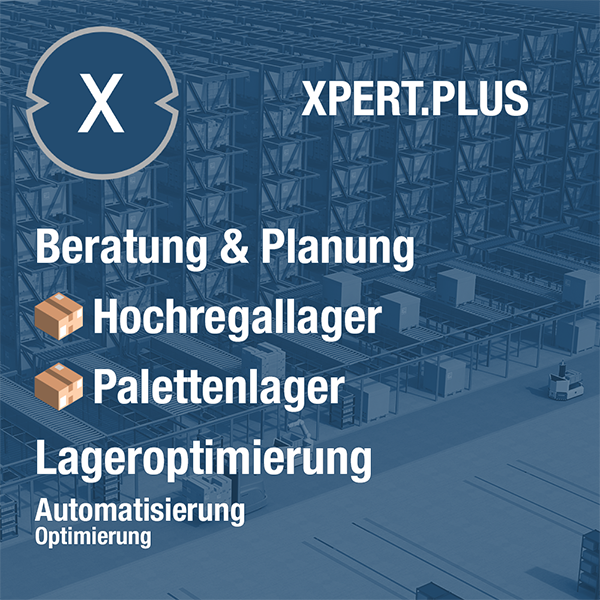
Xpert.plus warehouse optimization – high -bay warehouse such as pallet warehouse advice and planning
We are there for you – advice – planning – implementation – project management
☑️ Our business language is English or German
☑️ NEW: Correspondence in your national language!
I would be happy to serve you and my team as a personal advisor.
You can contact me by filling out the contact form or simply call me on +49 89 89 674 804 (Munich) . My email address is: wolfenstein ∂ xpert.digital
I'm looking forward to our joint project.









